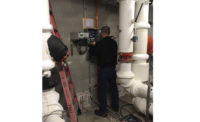Companies that strive to engage employees often report more efficient performance, grander productivity, increased revenue growth, and reduced employee turnover. However, disengaged employees outnumber engaged employees two to one in the U.S., according to The Henry Miller Group.
“Engaged employees are those who participate in how the business is run and are often the key to business success,” said Ken Misiewicz, owner, Pleune Service Co., Grand Rapids, Michigan. “Engaged employees are also safer — they’re paying attention and put great effort into taking care of themselves and respecting the rules of the road.”
“An engaged employee is going to work harder toward the company’s goals because they know and understand what those goals are,” said Travis Smith, Sky Heating and Air Conditioning, Portland, Oregon. “An engaged employee will also know how close they are to meeting those goals, since they will stay up to date on them, and it’s easier to work toward something when you get to see the progress in real time.”
Actively Engaging Employees
According to a study by Aon Hewitt, pay is one of the top drivers of employee engagement. Other drivers include career opportunities, reputation, recognition, communication, and job security.
According to Misiewicz, a number of Pleune’s roles are tied to financial performance in employees’ areas of responsibility; however, the company does not offer technician spiffs because “we want techs to be customer-focused without any conflicts of interest. Our employees do benefit when the company does well through our ESOP [employee stock ownership program] and profit sharing, neither of which is tied to a specific sale or job.”
Misiewicz said hiring the right people is the essential step in nurturing engaged employees. He also recommends creating an accountable and ethical work environment; frequently communicating plans, results, and problems; respecting employees and their ideas; giving opportunities to participate and make a difference; and offering growth and development opportunities.
Butch Welsch, owner, Welsch Heating and Cooling, St. Louis, believes the best way to keep employees engaged is to treat them as part of the company family.
“We have a company picnic, monthly company newsletter, and Christmas party. We really make an effort to make employees feel like they are part of our company family. We adhere very strictly to the old adage to ‘praise in public and criticize in private’ whenever dealing with an employee issue — good or bad.
“While I realize many large corporations are able to be successful without really having engaged employees, I believe, in the highly competitive business in which we operate, having fully engaged employees is absolutely necessary for success,” Welsch said.
Managing Resistance
Once in a while, managers come across an employee resistant to change, whether it’s adding a new product or a new manager. There are both right and wrong ways to handle these employees.
Roger Grochmal, CEO, AtlasCare Heating and Cooling, Oakville, Ontario, Canada, said his management team has committed to disciplining and firing employees who do not live up to the company’s core values.
“We use the values as a coaching tool. We spend a lot of time with staff communicating the ‘why’ of the changes we look to make in the business. People enjoy feeling like they are part of something bigger than themselves and when they do they have no difficulty committing. Once the naysayers left, and most of them left on their own free will, it became much easier to get staff to buy in to what we, and, most importantly, our customers, needed them to do.”
Smith said if employees are resistant, it is because owners/managers are not explaining how the change(s) will benefit employees, not just the company.
“For us, our big switch was adding ground-source heat pumps,” Smith explained. “At first, much of our crew didn’t care about them, but, now, whenever we have a class on geothermal, 95 percent of our employees show up to learn. It’s because they realize they benefit from the work because they can make more learning and installing geothermal equipment. As we take on new projects and types of work it allows newer technicians to specialize in something and earn
a higher wage.”
According to Smith, if employees are still resistant, they no longer have a job with his company. “I cannot let one person slow down the progress of a growing and fast-paced company. Fortunately, our employees do an excellent job of moving forward with us.”
Russ Donnici, president, Mechanical Air Service, San Jose, California, believes in setting a good example for employees. “Ultimately, the company sets the standard and employees either buy in [some more enthusiastically than others], or an evaluation needs to be done to determine if you want an uncommitted team member who sets a bad precedent,” he said. “We operate under one set of rules for everyone, period. We need committed team members, no lone wolves, and only one set of rules. I believe it starts at the top. In February, my firm will be 39 years old, and I expect myself to set a good example, and to always do whatever I say I am going to do. A man and a company are defined by how they honor their word. It means doing the right thing, even when it hurts, and sometimes it will.”
“A company is nothing more than the combined intelligence and efforts of its people,” said Misiewicz. “Anyone can buy a building, stock a truck, and rent uniforms, but the real assets are human capital. Just like any good investment, the best ones are hard to find and highly valued; that’s why our search to find the best people is relentless, and, once we have them, we invest heavily to make sure they reach their full potential.”
Publication date: 1/26/2015
Want more HVAC industry news and information? Join The NEWS on Facebook, Twitter, and LinkedIn today!










